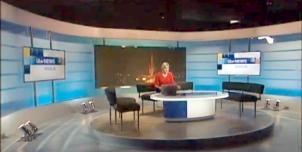Full Freeview on the Tacolneston (Norfolk, England) transmitter
| Google Streetview | Google map | Bing map | Google Earth | 52.518,1.139 or 52°31'6"N 1°8'22"E | NR16 1DW |
The symbol shows the location of the Tacolneston (Norfolk, England) transmitter which serves 330,000 homes. The bright green areas shown where the signal from this transmitter is strong, dark green areas are poorer signals. Those parts shown in yellow may have interference on the same frequency from other masts.
This transmitter has no current reported problems
The BBC and Digital UK report there are no faults or engineering work on the Tacolneston (Norfolk, England) transmitter._______
Digital television services are broadcast on a multiplexes (or Mux) where many stations occupy a single broadcast frequency, as shown below.
64QAM 8K 3/4 27.1Mb/s DVB-T MPEG2
DTG-12 QSPK 8K 3/4 8.0Mb/s DVB-T MPEG2
H/V: aerial position (horizontal or vertical)
Which Freeview channels does the Tacolneston transmitter broadcast?
If you have any kind of Freeview fault, follow this Freeview reset procedure first.Digital television services are broadcast on a multiplexes (or Mux) where many stations occupy a single broadcast frequency, as shown below.
64QAM 8K 3/4 27.1Mb/s DVB-T MPEG2
DTG-12 QSPK 8K 3/4 8.0Mb/s DVB-T MPEG2
H/V: aerial position (horizontal or vertical)
Which BBC and ITV regional news can I watch from the Tacolneston transmitter?

BBC Look East (East) 0.8m homes 3.2%
from Norwich NR2 1BH, 16km northeast (37°)
to BBC East region - 27 masts.
70% of BBC East (East) and BBC East (West) is shared output

ITV Anglia News 0.8m homes 3.2%
from NORWICH NR1 3JG, 16km northeast (38°)
to ITV Anglia (East) region - 26 masts.
All of lunch, weekend and 80% evening news is shared with Anglia (West)
Are there any self-help relays?
| Gt Yarmouth | Transposer | 1 km S town centre | 30 homes |
| Lowestoft (2) | Transposer | Rotterdam Rd | 125 homes |
How will the Tacolneston (Norfolk, England) transmission frequencies change over time?
| 1950s-80s | 1984-97 | 1997-98 | 1998-2011 | 2011-13 | 2013-18 | 2013-17 | 17 Jul 2018 | ||
| VHF | C/D E | C/D E | C/D E | E | E T | W T | W T | ||
| C3 | BBCtvwaves | ||||||||
| C31 | com7 | com7 | |||||||
| C32 | _local | ||||||||
| C37 | com8 | com8 | |||||||
| C39 | +ArqB | +ArqB | ArqB | ||||||
| C40 | BBCA | ||||||||
| C42 | SDN | SDN | SDN | SDN | |||||
| C43 | D3+4 | ||||||||
| C45 | ArqA | ArqA | ArqA | ArqA | |||||
| C46 | BBCB | ||||||||
| C50tv_off | BBCB | BBCB | |||||||
| C52tv_off | C5waves | C5waves | |||||||
| C55tv_off | BBC2waves | BBC2waves | BBC2waves | -BBCA | -BBCA | -BBCA | com7tv_off | ||
| C56tv_off | COM8tv_off | ||||||||
| C57tv_off | LNR | LNR | |||||||
| C59tv_off | ITVwaves | ITVwaves | ITVwaves | -D3+4 | -D3+4 | -D3+4 | |||
| C62 | BBC1waves | BBC1waves | BBC1waves | BBCB | |||||
| C65 | C4waves | C4waves | C4waves |
tv_off Being removed from Freeview (for 5G use) after November 2020 / June 2022 - more
Table shows multiplexes names see this article;
green background for transmission frequencies
Notes: + and - denote 166kHz offset; aerial group are shown as A B C/D E K W T
waves denotes analogue; digital switchover was 9 Nov 11 and 23 Nov 11.
How do the old analogue and currrent digital signal levels compare?
| Analogue 1-4 | 250kW | |
| SDN, ARQA, ARQB, BBCA, D3+4, BBCB | (-4dB) 100kW | |
| com7 | (-9.6dB) 27.4kW | |
| com8 | (-10.2dB) 24kW | |
| Mux 1*, Mux 2*, LNR | (-14dB) 10kW | |
| Mux A*, Mux B*, Mux C*, Mux D* | (-17dB) 5kW | |
| Analogue 5 | (-18dB) 4kW |
Local transmitter maps
Tacolneston Freeview Tacolneston DAB Tacolneston TV region BBC East Anglia (East micro region)Which companies have run the Channel 3 services in the Tacolneston transmitter area
|
|
Friday, 20 January 2017
M
Mardler 1:29 AM
I see I am not alone: a number of people is complaining that signal problems are increasing.
Tonight, two muxes were down near N. Walsham. The latest is Ch31. It has returned after wild s/q fluctuations but is unreliable.. S/q is varying rapidly from zero to 100%. Again: s/s is at max or very close on all stations but s/q is zero on affected stations.
All other muxes are fine.
Transmitter.
| link to this comment |
Mardler : Talcneston serves about 330k homes - if just one percent of those households has a problem, thats over 3k households. And the area served is notorious for having a geography which can mask the signal from the main transmitter, hence the fair number of Lite transmitters.
You can look at the status of the various transmitters yourself - they seem to be fine. Yes, it could be high pressure, etc, but the most likely and logical conclusion is that its your own system. You've already said you have an unreliable wall socket, so why do you think that somehow one mux on a transmitter is fine, whilst the other one is rubbish? That makes no sense.
| link to this comment |
H
hardy12:33 PM
yes there was a severe high pressure event . For a time I could tune in pictures from transmitters at Sandy Heath , Sudbury , Crystal palace and even Dover! The multiplex on UHF channel 31 is usually the most affected . I believe that interference from the Oxford transmitter is the main culprit because it transmits on most of the same UHF channels as Tacolneston. In North Norfolk we also pick up signals from the continent . Its probable that there will be less problems next year when Tacolneston will change to new frequencies (retune and possibly new aerial then needed) . You will be most affected by interference if you do not have the right aerial . Loft aerials are definitely not recommended in problem reception areas .
If you cannot stand loosing channels a couple of times a year I would recommend switching to Freesat . Freesat uses a dish just like sky and is not affected by high pressure weather. Freesat receivers are not expensive and receive all the same channels as freeview except QUEST and DAVE. FREESAT needs no subscription (unlike sky)----------------------my location Mundesley
| link to this comment |
H
hardy3:07 PM
I think the reason people keep wrongly assuming the problem is a fault at the transmitter is that interference in the pre digital analogue TV days often made patterns or snow on the picture . Interference on digital will often knock out a tv picture completely !
| link to this comment |
Friday, 17 February 2017
A
audrey Jenks6:04 PM
I have no reception on any channel when I tuned in this evening at 5pm, it was all working this morning at 9am, Apart from turning Television off the no body has been in the House, the aerial is in the Loft. Is there a fault at the Transmitter.
| link to this comment |
A
audrey Jenks6:07 PM
I have no idea if any channels are working as it just comes up no signal
| link to this comment |
A
audrey Jenks6:09 PM
Bury St. Edmunds
My postcode is IP31 3PD
| link to this comment |
audrey's: mapA's Freeview map terrainA's terrain plot wavesA's frequency data A's Freeview Detailed Coverage
A
audrey Jenks6:10 PM
Don't know what else you need me to do to get an answer.
| link to this comment |
MikeP
7:33 PM
7:33 PM
audrey Jenks:
Your TV signals could be coming from either Sudbury or Tacolnston transmitters. There are no reported problems with either stations.
That suggests a fault has occurred in your equipment. You should get a TV engineer to visit and check your system, unless you are able to do those checks yourself.
| link to this comment |
Monday, 13 March 2017
Select more comments
Your comment please!





